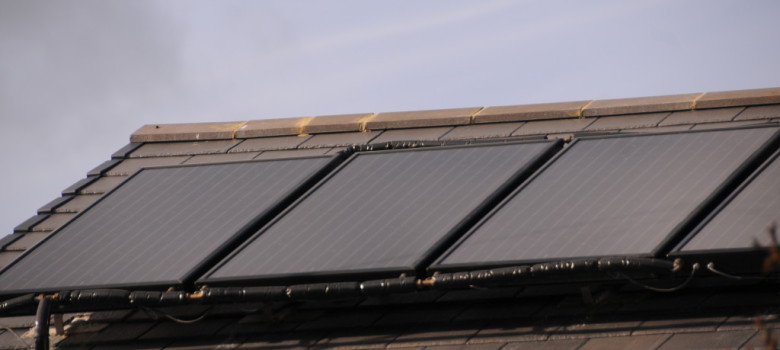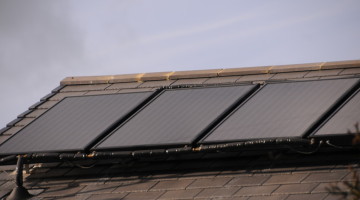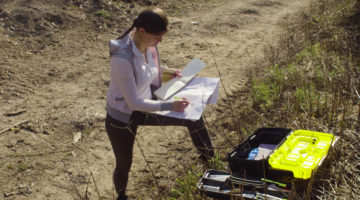
As you might expect, there has been a huge spike in interest in Solar Thermal with the introduction of the Green Homes Grant Voucher Scheme. The scheme, announced in July, has been introduced to drive the uptake of carbon saving technologies and solar thermal was just one of several ‘low carbon heat’ technologies the Government included.
How does the grant scheme work? Well, essentially if you are a homeowner, you can get a grant up to a maximum value of £5,000 towards the cost of installing the measure. There is a part contribution from the household though – typically (unless on certain Government entitlements) the homeowner will need to pay 1/3 of the costs. Take for example a solar thermal system that cost £4,500 – the homeowner would therefore need to cover £1,500 while the grant would cover the remaining £3,000.
So, in the following blog we look to answer the question is solar thermal worth it?
Solar thermal is cheaper than solar photovoltaic (PV) and coupled with the fact it takes up less room on the roof, for many customers it is their preferred option (you can find out the benefits and downsides of the two technologies here). Whilst payback for Solar PV is around 8-10 years, and is fairly consistent across properties, the payback for solar thermal is much more variable from house to house.
Below we give you an idea of the potential payback periods for solar thermal.
Cost of the system
We asked Giles from The Small Solar Company to give us an approximate cost for a new solar thermal system. Whilst he said that every home is different, with its own challenges, a pretty standard benchmark price is about £3,000 for a 3m2 solar thermal system, while a larger 6m2 system might cost nearer £4,500.
Savings
Much of the payback rate of the solar thermal system is down to the energy savings the solar thermal system creates once it is installed – if the savings are big, the payback is fast and vice versa. The savings here relate to producing hot water for free (from the Sun), rather than firing up whatever normally creates the hot water in your home (typically a gas boiler).
Unfortunately, the energy savings associated with solar thermal are more modest than solar PV, although it does depend on how much hot water you get through. The two key factors are how many people live in the property, and what sort of heating system you currently use.
For those on oil and LPG heating systems, savings are larger, because the per unit cost of fuel is higher. For those on electric off peak heating, savings are more modest because night rate electricity is fairly cheap. Gas systems offer savings somewhere in between. For a small system in a 2-person household, expected yearly energy savings range between £50 – £150. For a 4 bed house with 4 or 5 people and a 6m square system, savings will be much bigger – around £200-400.
RHI return
The good news is that it isn’t only the energy savings that drive the return on your solar thermal system.
Solar thermal systems are eligible for the Renewable Heat Incentive. This is a Government backed payment, which gets paid on a quarterly basis over 7 year period from when the system gets commissioned.
The good news is that you can claim both the Domestic RHI and the Green Home Grant when you install solar thermal. In order to do this, you must claim the Green Home Grant voucher first and then notify Ofgem that you have used it when you apply for accreditation to the Domestic RHI. The Green Homes Grant will then be deducted from your Domestic RHI payments.
So how is the RHI calculated for Solar Thermal?
Well, the amount of hot water produced by the solar thermal system is measured in kWh, and this number can be found on the MCS report. To calculate your RHI payment – you can simply multiply this kWh number by the RHI rate for solar thermal (19.2p / kWh) and this will give you your annual payment.
How the MCS installer arrives at the kWh number is far more complicated, but includes things like the number of occupants in the house (a larger number results in a higher payment), the efficiency of the existing boiler, whether or not electric showers are present in the property, the area that you live in (and the amount of sunshine you get) as well as the efficiency of the cylinder.
Typical RHI payments for solar thermal
A typical small 2m square system for a property with 1 occupant will pay just over a £1,000 over the 7 years. For a 6 person property with a large 6 meter square panel, you are looking at a payment in excess of £3,000.
The return from your Solar Thermal System
Given these guideline figures, we have produced a little table giving you a rough idea of the return on your investment!
Remember the figures in the table don’t include the Green Home grant you will be eligible for. Also, this is just a rough estimate, it doesn’t take into account maintenance costs, inflation, changing costs of fuel and many other minor influences on the rate of return. It does give you a pretty good idea of how long a system will take to pay back however.
| System Size | Cost | Occupants | RHI (7 yrs) | Est. Savings | Return |
| Small | £2,500 | 1 | £1,100 | £50 | 28 Years |
| Small | £2,500 | 2 | £1,350 | £100 | 11 Years |
| Mid | £3,500 | 3 | £1,850 | £150 | 11 Years |
| Mid | £3,500 | 4 | £2,350 | £200 | 7 Years |
| Large | £4,500 | 5 | £3,000 | £250 | 7 Years |
| Large | £4,500 | 6 | £3,250 | £300 | 6 Years |
What if you use less hot water?
The RHI is based on the installed system, so whether you use your hot water much is irrelevant to that payment.
The savings figures however will of course vary depending on how much and how efficiently you use your hot water. If you only shower once a week, your savings figure will be a fair bit lower!
Is solar thermal worth it?
With the Green Homes grant and the RHI there has never been a better time to get Solar thermal installed especially if you opt for a larger sized system, although the payback will be impacted depending on your hot water usage.
However, the larger the household, the higher the number of occupants, and the bigger the system, the quicker the return.












I am interested in getting a quaote for a solar thermal system
I wouldn’t bother they are a complete waste if time
Had mine 3 month it hasn’t even warmed enough water for a shower
I live in a 7 bed house with an indoor swimming pool with my wife and 2 young daughters (plan for one more kid.) The house has a big south facing roof with little shade (we’ve had Project Solar round already to quote for PV panels). Our gas energy bill fluctuates wildly due to heating the swimming pool in winter but i reckon averages out at around £200/month over the year.
We currently have 4 boilers in the house doing different things and there is a hot water tank in an airing cupboard and clearly some kind of very big tank in the loft. But i think there are also combi boilers heating the pool and other parts of the house.
Ultimately what i’d like is to reduce the heating bill as much as possible.
cheers
Rob
You should look at solar thermal
Hi Rob,
After some simple calculations, the best way to reduce your bill is to stop heating a massive swimming pool, especially in winter. Happy to help!
LOL
Brilliant info finally someone prepared to give estimate figures so people can make informed decisions!
I am interested in investing in renewable energy ….. however :-
I’m really interested to know how I would get return on investment in a Solar Thermal Panel system.
Main hot water requirement is for the Central Heating system, in the WINTER this is mainly in the EVENING.
Secondary main requirement is for showering .. in the EVENING or EARLY MORNING. Again, autumn, winter, spring solar energy not efficiently available at these times.
Solar energy is not efficiently available in the winter…
In the summer, when there is plentiful usable solar energy there is little requirement. The Central heating is then hardly ever used.
Please explain how I would gain from installing these Solar Thermal Panel systems.
I had them fit 3 months ago to be honest they are useless don’t heat enough water to have a shower
Save your money
I owned a house in New Zealand with a solar system installed in 1980. It was still working in 2015 when we moved. That was 35 years of free hot water 6 months of the year for the house. If you are in your forever home, this is a no brainer.
Are shared freehold properties eligible for the RHI?
From what I understand the RHI is not payable to the homeowner. The RHI payments go back to the energy saving grant, any surplus would go eventually however the pay off period will not provide any payment to the homeowner within the 7 year period.
The quotes I have have been considerably more around between £6000 and £7000 for a 4m panel set up, this does include a tank as we have a combi boiler. This is in the SW of England
The main benefit I can see is the carbon offset clearly this should be the most important one.
I have been quoted around £6500 for a 4m system in the South West of England. The RHI goes toward paying off the grant 1st not the homeowners 1/3 contribution as such the 7 year RHI would never pay anything to the homeowner as far as I can tell?? Would be interested to hear your thoughts?
This article has a big ommision – That being the RHI payment is reduced by the grant. This is done by dividing the grant by 7 to get an annual reduction, then removing this from RHI. Result you will NOT get a RHI payment. Example – Grant £3500 which equals £500 per year. RHI if you are lucky will be £250 per year Result NO RHI. This is an important point
After 31 March 2022 when the domestic RHI scheme closes to new applicants those ‘return on investment’ figures excluding RHI reduce to between 50(!) years for a small system, 1 occupant and 15 years for the large system, 6 occupants. If you are a day past the deadline having the system installed AND COMISSIONED you get nothing. So if you’re going to do it, do it in 2021 – or not at all
Hello. We currently have solar panels and air source heating. Are thermopanels going to make much difference?. We are also in receipt of RHI payments for the heating system and wondered if this would be affected.
We were looking at the govt wsrm homes grant and this was suggested but i dont want itbif it is not necessary.
No, you already have 2 of the best renewable options installed, don’t be fooled by their sales talk.
“Beneficial article at this stage as the world is moving to a greener earth. For those readers who have gained knowledge on solar energy, as a wind turbine parts manufacturer we bring to your notice some unique things about wind energy which is also a natural renewable energy source. The wind source provides valuable and renewable sources of energy which helps to power the homes with electricity generation. Wind energy has a very low impact on the environment than the conventional relying on power production from coal or oil.
If you reside in an area where you receive sufficient wind and are capable of investing the costs upfront, wind turbines certainly can pay you back for years to come.
“
Hi
I have a question , what kind pf boiler works best with Thermal panel system ? Combi boiler works ?
You will need a water tank to sore the hor water so a combi system cannot be used. We have a tri-coil cylinder with Gas, Solar or electric emersion…. we save about £80 a year on heating water (Solar gain between April and September only in the UK) but these systems are so comlicated and expensive to maintain if anything goes wrong (like ours) the repair/maintenance cost over its life time would negate any benefits. So I would never recommend unless you have a massive swiming pool and lived in Spain. I have decided to de-comission mine instead of repairng it…
Bought my 3 panel system very cheaply from a clearance sale. Self installed apart from the twin coil tank. Total cost under £1000. Gas is still very cheap per kwh so it will still take around 10 years to pay itself back. A bit less as gas prices rise in the future. RHI and GHG completely pointless for a competent DIY’er.
Which panels are most efficient? solar PVT or thermodynamic panels
Efficiency is the wrong thing to measure. A polysilicon solar photovoltaic panel only gets about 15% sunlight to DC conversion efficiency, but this is high quality mains electricity which you can use for anything. Vacuum tubes with greenhouse coating move sunlight to heat in your water system with very high efficiency, but from there you might or might not use your hot water. Other types of solar thermal collector might lose more heatthan tubes (lower efficiency) but by being cheaper and bigger collect more heat power on sunny days. If still in doubt, pay a student who got good grades in A level physics to explain it to you.
Never again! We have had solar thermal water heating for over 10 years. At first it was great but then it started to cost to have an engineer come out to fix minor faults (if you could find an engineer to attend!) Our system has been out of action now for over 8 months because a replacement part (sensor) is no longer available. Solutions – try and find second hand parts, replace half the system with new parts (sensors, control unit and pumps) or scrap the lot. Our system is a Viessmann – supposedly one of the best.
So buyer beware.
By contrast, our solar pv system and air to air heating have been a big success. W have a diverter box that routes excess electricity to our hot water cylinder (immersion heater) instead of the grid which supplies almost all of our hot water needs from April to October.
If we were starting again my priorities would be:
1. air to air heating and cooling (if the property is suitable)
2. solar pv with excess generation diverted to hot water immersion
Interestingly, no significant government grants or incentives available for the above!
Thermodynamic panels work in winter in the UK – completely different technology.
I installed two SHW flat panels about 4m squared on our not quite optimum roof angle in 2011 for £4k we get a 50% RHI subsidy so they cost us £2k. They paid for themselves after about 7 years in reduced bills. Our boiler is now turned off for a bit more than 6 months of the year for a family of 4 (and therefore should last twice as long) Being made of glass and metal with no expensive rare earth metals the panels are easily recyclable and should last 50 years – 10-15 for a Air heat pump and 20 for solar PV. They can work during a power cut and I use all the energy I make rather than exporting. I can also use the surplus hot water in summer to flush out the drains of fat and also to pour onto the drive (70C) to kill the weeds so no noxious herbicides. Quite frankly the best thing I have bought and better than my solar PV.
I have not needed to do any maintenance apart from squirt the hose on the panels to clear the dust after the builders were in.